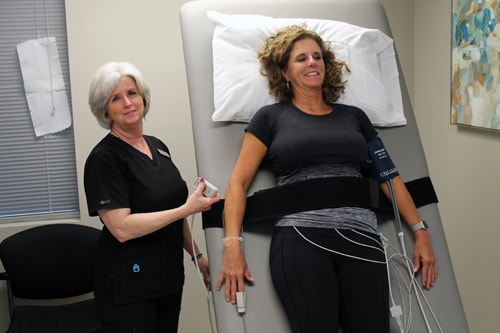
Tilt Table Test (Head up tilt)
A tilt table test is a way to find out why someone faints or feels like they are going to faint. During the test, you are asked to lie on an automated table that is able to bring you up to a near standing position, usually 60-80 degrees. There is a footboard at the bottom of the table and there are 2 straps to hold you in place should you become weak or pass out. A technician will measure your blood pressure and heart rate for several minutes before the test, at set intervals during the test and after the test. The technician will continuously monitor how you are feeling throughout the tests. Symptoms are recorded along with the blood pressure and heart rate. After a period of 20-45 minutes of tilt, the table is then lowered to the flat position again. The table moves very slowly going up and then back down after the appropriate amount of time. Infrequently someone will pass out on the tilt table. Because the patient is strapped to the table and a technician is close by, even if passing out does occur with the test, it is much safer than passing out under real life circumstances. If fainting occurs, the table is immediately lowered to the flat position. Sometimes a near fainting sensation will occur during the test but unless your blood pressure or heart rate is unstable, the test is typically continued.
Who needs a Tilt Table Test?
This test is administered to people who have a history of syncope (passing out) or presyncope (almost passing out). The cause of these symptoms can sometimes be very difficult to diagnose and a doctor may recommend this test if other testing such as your history, physical exam and EKG do not give answers to the cause of the symptom.
Syncope or presyncope can be seen in people with an abnormally slow or abnormally fast heartbeat, low blood sugar, low blood pressure or who experience prolonged bed rest. Also, those people who take certain medications or those with certain nervous system disorders, including Parkinson’s disease and Dysautonomia, can experience syncope or presyncope. Sometimes fainting can be due to psychological stress in which case you may pass out on the tilt table, but there is no change in the blood pressure or heart rate to account for the passing out.
What to expect with your test?
The initial testing is done without the use of any medication. If the initial part of the test is negative, then you may be given medicine to make your heartbeat faster and stronger, and thereby making you more sensitive to the effects of the tilt table test. (Dr. Moore does not give any medication during this test.)
The technician will apply electrodes to your chest. Men may have to have the area shaved before the electrodes are placed. Once the electrodes are placed you will lie down on the table and after a predetermined time in the flat position the head of the table will slowly raise to an angle of 60-80 degrees. Your blood pressure and heart rate will be monitored throughout the test.
The test is over when the time has elapsed or if you pass out. If fainting occurs during the test, you are immediately brought back down to the starting position and the blood pressure and heart rate are continuously monitored.
What are the risks of the tilt table test?
Occasionally someone will pass out on the tilt table. Because you are strapped to the table and a technician is close by, even if passing out does occur with the test, it is much safer than passing out under real life circumstances. The table is immediately lowered to the flat position if passing out occurs.
What to expect after your test?
Immediately after the test, you may feel tired, lightheaded or even a little nauseated. This usually goes away within a few minutes. You should be able to return to your usual activities after the test. If you do pass out on the test, you may feel tired or lightheaded for a few hours after the test.
Your doctor will review the information obtained during the test and apply the results to your particular situation to make treatment recommendations for you.
Dr. Moore will give you your test results before you leave the office.
How do you prepare for your tilt table test?
- In some cases you should avoid eating or drinking within 2 hours of the test. If in doubt, call your physicians office for instructions.
- Dr. Moore prefers you have a small snack such as peanut butter crackers or yogurt within 2 hours of your appointment.
- You should be adequately hydrated on the day of your appointment assuring that you have at least 16 ounces of water within 2 hours of your appointment.
- You should avoid caffeine and alcohol for 24 hours.
- You should not smoke within 2 hours of your test.
- If you take medicines on a regular basis, ask your doctor what medicines, if any, you should leave off the day of the test. (When deemed safe to omit, medications called Beta-blockers are usually not taken the day of your appointment.)
- Do not use lotions on your chest the day of your appointment.
